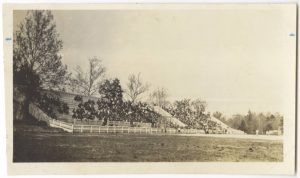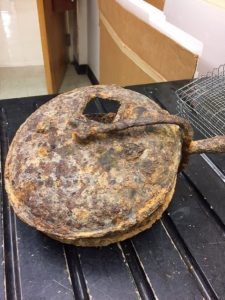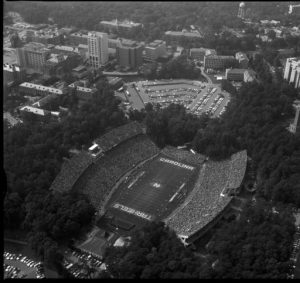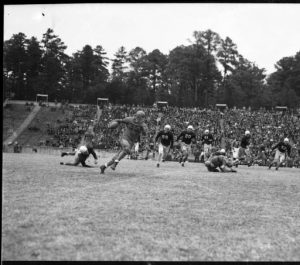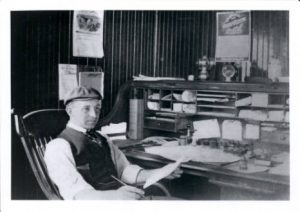The stage was set. The University of North Carolina was to face off against Wake Forest in 1888 in the brand new sport of American football. UNC had never before played a single game of football, let alone played a sport against another school. UNC first developed athletic teams in 1876, and very soon after the school reopened from the Civil War. Up until 1888, students at UNC had only played intramural sports, with students competing against one another for recreational purposes. This game, therefore, marked a milestone in UNC sports history. The venue for this momentous event? The North Carolina State Fair. A newspaper called the News and Observer in Raleigh stated that the game will be played “inside the oval in front of the grand stand.”[1] It appeared to be something of a spectacle for those in attendance. This seems like a far cry from the gigantic, loud stadium atmosphere that UNC students are used to today. After the sport of football became more popular in the South, and therefore at UNC, there became a need to establish a playing facility on campus.
The First Field
Isaac Emerson, an 1879 graduate of UNC, heard that there was a demand for a new athletic field. He wanted to throw his name into the discussion about making this new field. Finally, in 1914, UNC built its first athletic field for football, and it was called Emerson Field. The field was originally located where Davis Library and the FPG Student Union are today. Games were held at this location all through World War I, and into the mid-1920’s.[2]
In one of the last years of playing at Emerson Field, the UNC football team went a mediocre 4-4 on the season, and many felt that it was time to build a new stadium, in order to get a fresh start on the program. In 1926, 18 UNC alumni came together in Durham to discuss financing for a new “University Stadium.” Among this group, there were many who went on to have other impacts on the school, including names like Morehead and Carr. The purpose of bringing together these alumni was to see if they could muster up enough money to construct this new stadium. The first few weeks went well in terms of donations, and the University was able to obtain $28,000 in that amount of time. By this point, however, one of the richest alumni from UNC had not yet been notified of the plans to build this new stadium. This man was William Rand Kenan, Jr. At this time, he was living and working in New York City, as his business endeavors in the carbide industry had allowed him to amass a huge fortune. When the plans made it to his office in 1926, he jumped on the opportunity to leave a legacy at his former school, where he himself had once played football in the early 1890’s.[3]
Originally, Kenan was going to donate the same amount of money that the other donors had given to start the stadium project. However, he decided that it might be a better idea to honor his parents by making a more sizable donation in their honor. In 1926, Mr. Kenan came down from New York City to Chapel Hill to discuss the deal with Charles Woollen and the architect Arthur Nash. Charles Woollen held the position of the second in command to the Athletic Director at the time. In their discussion, they concluded that the new stadium would lie in a natural valley to the south of the current campus. This came as a surprise to Mr. Kenan, who thought that it would be built on a flat surface and then upward as expansions were made. His main fear in building the stadium in a ravine was that they might, at some point, hit rock and have to spend too much money attempting to remove it. However, he eventually came around when he was told that the natural hillsides already present at the site would be used to support the seating. After this was settled, the discussion turned to what the eventual shape of the stadium should be. Two main style types came forward: the classic horseshoe style or a design having two large banks of seating on either side. The decided to go with the style of having two main banks of seating. After the physical aspects of the stadium were discussed, the building committee decided to allow Mr. Kenan to pursue his 24,000 seat stadium, to which he planned to donate $275,000 for construction. Construction began, and, as expected, it hit some snags. The goal for the construction was to have the whole stadium completed by the game against key rival University of Virginia in 1927. However, the presence of underground rock made it difficult to complete the construction on time. On top of that, Chapel Hill experienced a heavy snow during construction, causing further delays. Woollen estimated that the building of the stadium was about six weeks behind the proposed schedule due to these snags.[4]
Changing the Campus
The Chapel Hill Weekly, the local newspaper of the residents of Chapel Hill, wrote in 1927 that the construction noise was extremely loud, and that it was angering residents. The use of dynamite in the construction contributed to the problem. One blast was so large that it supposedly blew out fourteen windows in Old East Residence Hall. Town meetings were held, and many citizens complained about the noise, with one citizen even contacting an expert with experience building the New York City subway system on how to reduce dynamite explosions. Later on in the construction process, concrete seating banks were installed on the stands, and were built in a curve, so that the spectators could see more of the game. Much later, a field house was added to the east endzone, and Mr. Kenan agreed to fund it for the price of $28,000. The field house addition was meant to complement the rest of the stadium, and its roof was made of red tiles. The design of the roof was based on the pattern of Spencer Dormitory, which is located on Franklin Street. Finally, on November 12, 1927, Kenan Stadium held its first football game, pitting the Tar Heels against Davidson. “The towering concrete stands rose to commanding heights on each side of the playing field, sheltering a crowd that seemed almost swallowed in the wide expanse of the amphitheatre,” wrote the Daily Tar Heel in 1927.[5] Carolina would go on to win its first game at its beautiful, new stadium 27-0.[6]
For this first game in Kenan Stadium in 1927, it is important to touch on how this new stadium was being used, and just how much has changed. The unique placing of shrubs around the entrance to the stadium was the idea of the first professor of botany at UNC, Dr. William C. Coker. A newspaper from the time commented that this idea was one of many brilliant ones that Coker had contributed to the University. The tickets to this first game were priced at $2 per person, for every seat. The idea was that there were no bad seats; thus every seat was equally priced. In total, it was estimated that nine thousand fans attended this first game at Kenan Stadium. A short time later, the rivalry game between UNC and UVA was to serve as the official christening and overall dedication to the new structure. This game was played in front of an estimated 28,000 fans. In attendance were the Kenan’s, the Venables, and the Moreheads. In the years after the 1927 inaugural season of Kenan Stadium, new stadiums at other universities all over the country began to be built. Others were often larger and more imposing than Kenan Stadium. However, many people who were fortunate enough to attend a game at Kenan Stadium during this time commented on just how beautiful it was. The one major theme of these praises? How pretty the stadium was with the trees and forest all around it.[7]
Much like many other stadiums in the South during the late 1920’s and 1930’s, Kenan Stadium faced a hard challenge during the Great Depression. A lack of money made it difficult to maintain upkeep on stadiums and, therefore, many teams in the South suffered. For UNC, Woollen blamed poor ticket sales on both the Depression and bad weather. The center of the field at Kenan Stadium had sunk about a foot due to muddy conditions, and Woollen felt that if the field was in this condition, it would therefore hurt people’s desire to come watch games. Due to this, Woollen decided to buy a waterproof canvas field cover for the price of $4,500. He felt that the good condition of the field brought by purchasing this cover would bring in enough sales to eventually cover the expenses.
The popularity of UNC football, and Kenan Stadium by association grew during the years following World War II. Players like Art Weiner and Charlie Justice drew in many fans to the stadium, and a need for more seats came about. Mr. Kenan himself helped fund the installation of more seats, which took the form of wooden bleachers on either endzone. They also added seats to the top of the seats that were already there, which expanded the seating capacity to 44,000. In 1949, Mr. Kenan spent $90,000 for half the cost of installing two structures at midfield on either side of the field. The two structures would become the press boxes for the stadium. Around the same time, $65,000 was spent to improve the field house in the endzone. One major change to the field house during these renovations was that it became a quasi-dormitory. Since most football games were held on Saturdays, the field house was to be a place for football players to sleep on Friday nights before games.
UNC football made a change to its coaching staff in 1956, and it had a direct impact on Kenan Stadium right from the start. The hiring of new head coach Jim Tatum saw with it a huge increase in seating. After his death, the athletic director at the time felt that, since he noticed a huge increase in enrollment in recent years, the stadium should add more seating. In 1963, the upper decks were added. Weirdly, this did not increase the size of the stadium. When they added the upper decks, the also removed the endzone seating; however they had the seats available for use when needed. Around this time, in 1965, Mr. Kenan died at age ninety-three, and $95 million of his vast estate became part of the William R. Kenan Jr. Charitable Trust. This trust came into possession of Frank Kenan, a son of one of Mr. Kenan’s cousins. This fund, of course, would have huge implications for the future of the stadium.[8]
Although many of the renovations that took place to Kenan Stadium over the years were very drastic, some of them were very small. However, they were just as important in making the stadium what it is today. One main issue that caused the need for more renovations was the early lack of women’s restrooms. An article from the Daily Tar Heel in 1979 mentions that four new women’s restrooms were added to Kenan, for the purpose of solving the problem of long lines in the restrooms.[9] Again, something that today seems like a small issue, but at one point was really something that needed to be addressed. When the stadium was first built and was being used, many women did not attend the football games. On top of these renovations, the old wooden bleachers were replaced by new metal bleachers, and some even got back rests installed on them. They also renovated the Chancellor’s box, while at the same time adding boxes for the visiting team’s athletic directors.
The 1970’s
In the early years of the 1970’s, certain events led up to more renovations for Kenan Stadium. For example, a drunken fan around this time somehow wandered through security during a football game and offered the current coach some of his drink. Due to this event, a fence was put around the field, something that today seems like such a normal aspect of football stadiums. To make the fencing seem more aesthetically pleasing, the University also planted hedges inside the fencing, and they would eventually grow into and around the fence. To this day, it is very hard to see the fencing around the stadium, mostly because of the thick bushes that are still around it. On top of adding the bushes and fence, a tarmac was added between the bleachers and the field. This tarmac was made of asphalt, and it is still in place at Kenan Stadium today. One of the assistant coaches in the early 1970’s, Clyde Walker, had the idea of making the endzones more visually pleasing. To do this, his idea was to add some shrubbery to the endzones, and make them show a U-N-C design. This was very important for the University, because at this time, many games were beginning to be shown on television, and showing the name of the University was a great thing to do.
Unfortunately, Kenan Stadium has experienced some events that have not been shared for general public knowledge. Some of these events are quite undesirable. One example came in the already unstable times of the early 1970’s. Athletic Director Homer Rice was presented with an issue at the time, when a man ran for Homecoming queen. As is the tradition today, Homecoming ceremonies took place at Kenan Stadium, often during halftime of a larger game. When Rice found out that the Homecoming queen could potentially be a man, he conspired with the current band director John Yesulaitis to make sure that nothing went on during the ceremony that went against their more traditional ways and values. Much to the chagrin of the current Chancellor Sitterson, Rice made sure that when the man running for queen’s name was called, the band played the UNC fight song very loudly. The idea for this obviously being so that the crowd could not hear a man’s name being called for Homecoming queen. After this event, Rice was extremely unapologetic for his actions. It is these types of events that bring about the negative side of Kenan Stadium, or any building for that matter.
New Changes
When Homer Rice left his office of Athletic Director in 1976, the new Athletic Director Bill Cobey decided that he was tired of seeing how long it took the cleaning crews to clean Kenan Stadium after games. He implemented the practice of having Naval ROTC members at UNC help clean up. This practice is still continued today. On top of that change, he felt that more needed to be done to promote the team name. Due to this, “Carolina” and “Tar Heels” were painted onto the endzones of the field. He also started the idea of having “Carolina Fever,” as well as making the brand noticed on many different forms of media. Partially due to this, but also due to the success of the football team in the late 1970’s and early 1980’s, every UNC game at Kenan Stadium was sold out from 1977 to 1983. During this time, the capacity of Kenan Stadium was 49,500. Athletic Directors that came in years after this all felt the particular beauty of Kenan Stadium, and how it was complemented so well with the trees around it. Not only that, but national outlets like magazines and newspapers at the time heralded Kenan Stadium as one of the best places to watch college football. For some time, the ideas of expanding Kenan Stadium were put on the “backburner,” according to the Daily Tar Heel. One article from 1983 states that the priority at the time was to complete the Student Activities Center, and to think about Kenan expansions at a later time.[10]
The old, unofficial rule set into place for Kenan Stadium at its founding was that no permanent structure at the site could ever rise higher than the trees surrounding it. The trees were a crucial part of the beauty of Kenan Stadium, and one Daily Tar Heel article from 1956 claims that other school’s stadiums, like Tennessee’s Shields-Watkins, “can’t begin to compare with Kenan among the pines.”[11] This rule became difficult to follow in the mid-1980’s, when permanent lights needed to be put in for night games, and the press box was becoming too small for the ever-growing national attention that UNC was getting. Due to this, they needed to contact Frank Kenan.[12]
Since Frank Kenan had at his disposal the fund that was set up at the end of Mr. Kenan’s life, the late 1980’s brought many new additions to the stadium. In 1988, the press box that was built in the 1940’s was torn down. After doing this, the upper seating decks were connected in the center on both sides of the field, and a new press box was built on the South side. This increased capacity to 52,000. These new changes cost about $7.1 million. Frank Kenan was again called, and he made it clear from the beginning that he did not want to make the stadium huge like at some other schools. However, he did approve a change that built a four-story football building in the West endzone that offered more seating. Construction began in 1996 to build the Frank Kenan Football Center, which was to include locker and training rooms. This caused the capacity to reach 58,000 by 1997, and to 60,000 in 1998 by filling in the two corners between the older seating areas.[13]
In 2007, a meeting was convened to discuss more expansions to the stadium. The idea that was proposed would eventually become the Blue Zone that is there at Kenan Stadium today. It would cost around $70,000 to build, and it would add around 3,000 seats. Construction began in 2010, after demolition of the original 1927 Kenan Field House. The Blue Zone is designed to allow everyone sitting there to be able to see the Bell Tower. Many people who have been at the University in some way for many years say that this project was very important and needed to be done. Some even say that it does not even appear to be an add-on.[14]
Kenan Stadium, and its long history have become one of the central aspects of UNC athletics. It would have been very difficult to imagine this stadium ever being built without the huge donations from William Rand Kenan Jr. His life and family had a huge impact on the University, and it is important to know about them, since they are the namesake for so many things on campus.
The Stadium Giver
William Rand Kenan Jr. was born in the Spring of 1872 in Wilmington, North Carolina. His family consisted of many conservative activists, and he spent much of his childhood in Liberty Hall, the Kenan family homestead in Duplin County. His great-great-grandfather was a veteran of the Revolutionary War, who also owned 37 slaves. His great-grandfathers were both prominent slave owners in both Florida and Alabama. His grandfather never left Duplin County, and also owned many slaves, who he would often lease out to help build railroads. His father, “Buck,” was one of four children born at Liberty Hall, and grew up with a private school education. He entered UNC as a freshman at 15 years old. During the Civil War, Buck was too young to join, so he continued to study at UNC. His brothers, however, had various roles within the Confederacy, including his father, who was elected to the Confederate Congress in Richmond, Virginia. Buck was later wounded in battle, but went on to be a survivor at Appomattox. He later moved to Wilmington with his wife Mollie. He became an activist against Reconstruction. When Will Kenan was younger, he would enjoy playing at Liberty Hall with his many children relatives, as well as the servant’s children.[15] This is quite interesting, considering his father was a Confederate veteran as well as a conservative activist. He entered into school at UNC-Chapel Hill in the fall of 1890, and moved into South Building for housing. He enjoyed a very successful freshman year at UNC academically. The same cannot be said about some of his acquaintances, some of which flunked out. It was during this year at UNC that Kenan experienced “blacking.” This was a rite of passage among freshmen by their upperclassmen, in which they would get covered in shoe polish during a midnight raid. Upperclassmen would barge into rooms in white robes and masks, and then would deliberately force the “blacked” freshmen to do whatever they say. This is obviously very similar to the tactics used by the Ku Klux Klan, and it is very consistent with the postwar South. Following the death of famed Klan leader William Saunders, Kenan was one of many students to approve the passing of a no-hazing rule on campus, which helped to end the practice of blacking. He would later go on to play both baseball and football at UNC.[16]
He started his illustrious economic career with a job in the carbide industry. At the start of this, he worked with Dr. Francis Preston Venable, a former President of UNC, to help develop a “commercial method for making calcium carbide.” This waste product would then be used for the making of acetylene gas.[17] It was a very big industry at the time, and that helped Kenan to propel his career forwards. He went to Australia to work in their carbide industry early on as well.[18] He became involved with businessman H.M. Flagler, and that helped him to gain more traction and wealth. He was known as a scientist, discoverer of carbide, and an engineer. He married his wife, Alice, in 1904. During the 1920’s, Will Kenan became a builder and philanthropist.[19] He passed away in 1965. His obituary in the New York Times calls him a prominent industrialist.[20]
[1] “The Attendance At The Fair Yesterday.” News and Observer, October 18, 1888. https://universityofnorthcarolinaatchapelhill.newspapers.com/image/76415388/?terms=state%2Bfair.
[2] Lee Pace, Football in a Forest: The Life and Times of Kenan Memorial Stadium (Pace Enterprises Inc., 2016) p. 52-53
[3] Lee Pace, Football in a Forest: The Life and Times of Kenan Memorial Stadium (Pace Enterprises Inc., 2016) p. 54-55
[4] Lee Pace, Football in a Forest: The Life and Times of Kenan Memorial Stadium (Pace Enterprises Inc., 2016) p. 87
[5] “Tar Heels Christen New Stadium by Impressive 27-0 Win Over Wildcats; Carolina Launches Diversified Attack.” The Daily Tar Heel, November 15, 1927. https://universityofnorthcarolinaatchapelhill.newspapers.com/image/67858102/.
[6] Lee Pace, Football in a Forest: The Life and Times of Kenan Memorial Stadium (Pace Enterprises Inc., 2016) p. 83-89
[7] Lee Pace, Football in a Forest: The Life and Times of Kenan Memorial Stadium (Pace Enterprises Inc., 2016) p. 104
[8] Lee Pace, Football in a Forest: The Life and Times of Kenan Memorial Stadium (Pace Enterprises Inc., 2016) p. 101-107
[9] Fish, John. “Stadium Additions Give Comfort, Relief.” The Daily Tar Heel, July 9, 1979. https://universityofnorthcarolinaatchapelhill.newspapers.com/image/67905435/?terms=women’s%2Brestrooms.
[10] Yardley, Jim. “Kenan Expansion Plans Remain on Back Burner.” The Daily Tar Heel, February 14, 1983. https://universityofnorthcarolinaatchapelhill.newspapers.com/image/67940028/?terms=expansions.
[11] Cheek, Larry. “Sports.” The Daily Tar Heel, March 11, 1956. https://universityofnorthcarolinaatchapelhill.newspapers.com/image/70394715/?terms=kenan%2Bshields-watkins.
[12] Lee Pace, Football in a Forest: The Life and Times of Kenan Memorial Stadium (Pace Enterprises Inc., 2016) p. 119-125
[13] Lee Pace, Football in a Forest: The Life and Times of Kenan Memorial Stadium (Pace Enterprises Inc., 2016) p. 137-143
[14] Lee Pace, Football in a Forest: The Life and Times of Kenan Memorial Stadium (Pace Enterprises Inc., 2016) p. 153-163
[15] Walter E. Campbell, Across Fortune’s Tracks: A Biography of William Rand Kenan, Jr. (Chapel Hill and London: The University of North Carolina Press, 1996) p. 3-9
[16] Walter E. Campbell, Across Fortune’s Tracks: A Biography of William Rand Kenan, Jr. (Chapel Hill and London: The University of North Carolina Press, 1996) p. 51-57
[17] Connor, Otelia. “Venable Convinced People That UNC Deserved Money.” The Daily Tar Heel, September 26, 1965. https://universityofnorthcarolinaatchapelhill.newspapers.com/image/67937068/?terms=william%2Brand%2Bkenan%2Bjr.
[18] Walter E. Campbell, Across Fortune’s Tracks: A Biography of William Rand Kenan, Jr. (Chapel Hill and London: The University of North Carolina Press, 1996) p. 103-137
[19] Walter E. Campbell, Across Fortune’s Tracks: A Biography of William Rand Kenan, Jr. (Chapel Hill and London: The University of North Carolina Press, 1996) p. 138-147, 209
[20] William rand kenan jr. dies; industrialist and engineer, 93. (1965, Jul 29). New York Times (1923-Current File) Retrieved from http://libproxy.lib.unc.edu/login?url=http://search.proquest.com/docview/116949802?accountid=14244
Photos:
- Folder 0245: Emerson Field, 1915-1921: Scan 5
- Photo by Robert Lyerly: Special thanks to the RLA at UNC
- Aerial view showing Kenan Memorial football stadium, Morehead-Patterson Bell Tower, and other structures at University of North Carolina, Chapel Hill, NC. Photo by Hugh Morton, 1976; University of North Carolina at Chapel Hill, Wilson Library, North Carolina Collection Photographic Archives
- UNC vs. Virginia football. Photo by Hugh Morton, 1941; Hugh Morton Collection of Photographs and Films, University of North Carolina at Chapel Hill, Wilson Library, North Carolina Collection Photographic Archives
- William Rand Kenan Jr. University of North Carolina at Chapel Hill, Wilson Library, North Carolina Collection Photographic Archives

